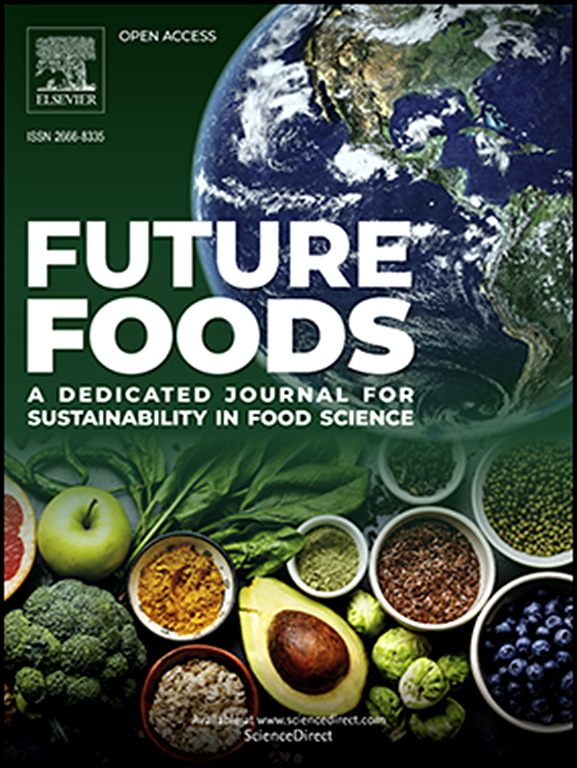小型近红外传感器和人工智能技术实时检测掺入金属黄的姜黄
IF 8.2
Q1 FOOD SCIENCE & TECHNOLOGY
引用次数: 0
摘要
鉴于香料市场体现了复杂和全球化的供应链,香料一直是欧盟(EU)欺诈者最具针对性的食品之一。姜黄是一种广泛使用的香料,以其鲜艳的颜色、味道和据称的健康优势而闻名。它在解决各种健康问题方面的药用特性引发了全球需求的激增,引发了人们对香料行业诚信的担忧。姜黄中最常见和最危险的掺假物是未经批准的合成偶氮染料,特别是Metanil黄(MY)。为了解决姜黄供应链中的不当行为,本研究提出了一种可扩展的方法,利用小型化近红外(NIR) (1350-2500 nm)传感器结合先进的人工智能(AI)技术来检测姜黄中MY的存在。使用便携式设备和高分辨率台式可见和近红外短波红外(VNIR-SWIR)光谱辐射计分析了包含202个样品的数据集,包括纯姜黄、MY及其混合物(5%-40% w/w)。采用多种光谱预处理,并使用随机森林(RF)、XGBoost和支持向量机(SVM)进行分类。该模型对小型化传感器采集的原始反射光谱的处理精度最高(98%,κ = 0.97)。通过特征重要性分析,确定了与MY化学结构相关的关键诊断波长(如1495、1640、1675、2155、2475 nm)。这项工作强调了便携式、低成本近红外传感器作为扩大食品认证途径的工具的潜力,实现了对MY掺假的快速、无损检测,实际检测限为5% w/w。本文章由计算机程序翻译,如有差异,请以英文原文为准。

Real-time detection of turmeric adulteration with metanil yellow using a miniaturized NIR sensor and AI techniques
Spices have been among the most targeted foods in the European Union (EU) for fraudsters, given that the spice market exemplifies complex and globalized supply chains. Turmeric is a widely used spice famous for its vivid color, flavor, and purported health advantages. Its medicinal properties in addressing various health issues have sparked a surge in global demand, raising concerns about the spice industry’s integrity. The most common and hazardous adulterants of turmeric, added for financial gain, are synthetic, non-authorized azo dyes, particularly Metanil Yellow (MY). To tackle malpractices in the turmeric supply chain, this study proposes a scalable method utilizing a miniaturized near-infrared (NIR) (1350–2500 nm) sensor coupled with advanced Artificial Intelligence (AI) techniques to detect the presence of MY in turmeric. A dataset comprising 202 samples, including pure turmeric, MY, and their admixtures (5%–40% w/w), was analyzed using both the portable device and a high-resolution benchtop visible and near-infrared–short-wave infrared (VNIR–SWIR) spectroradiometer. Multiple spectral pre-treatments were applied, and classification was performed using Random Forest (RF), XGBoost, and Support Vector Machines (SVM). The best performance was achieved by the RF model on raw reflectance spectra collected with the miniaturized sensor (98% accuracy, = 0.97). Key diagnostic wavelengths (e.g., 1495, 1640, 1675, 2155, 2475 nm) linked to MY’s chemical structure were pinpointed through feature importance analysis. This work highlights the potential of portable, low-cost NIR sensors as tools for broadening access to food authentication, enabling rapid, non-destructive testing with a practical limit of detection of 5% w/w for MY adulteration.
求助全文
通过发布文献求助,成功后即可免费获取论文全文。
去求助
来源期刊

Future Foods
Agricultural and Biological Sciences-Food Science
CiteScore
8.60
自引率
0.00%
发文量
97
审稿时长
15 weeks
期刊介绍:
Future Foods is a specialized journal that is dedicated to tackling the challenges posed by climate change and the need for sustainability in the realm of food production. The journal recognizes the imperative to transform current food manufacturing and consumption practices to meet the dietary needs of a burgeoning global population while simultaneously curbing environmental degradation.
The mission of Future Foods is to disseminate research that aligns with the goal of fostering the development of innovative technologies and alternative food sources to establish more sustainable food systems. The journal is committed to publishing high-quality, peer-reviewed articles that contribute to the advancement of sustainable food practices.
Abstracting and indexing:
Scopus
Directory of Open Access Journals (DOAJ)
Emerging Sources Citation Index (ESCI)
SCImago Journal Rank (SJR)
SNIP
 求助内容:
求助内容: 应助结果提醒方式:
应助结果提醒方式:


